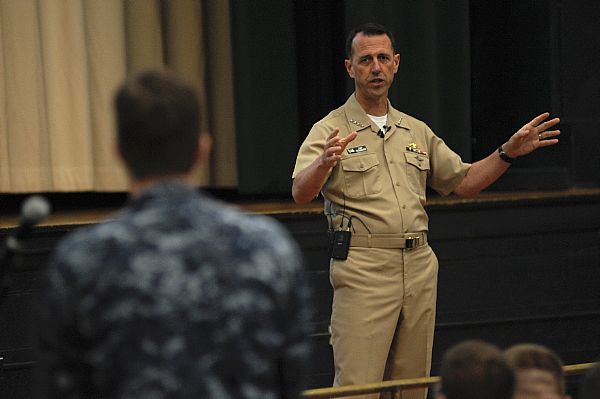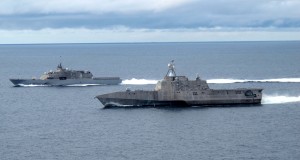CNO: Warfighting Trumps Presence; ORP, EW Win; LCS Likely Loser
Posted on

Adm. John Richardson, Chief of Naval Operations, addresses sailors in Norfolk
[UPDATED with Rep. Forbes & Robert Martinage comments] WASHINGTON: Presence? What’s “presence”?” Once a primary measure of naval power and a driving factor in shipbuilding decisions, the word “presence” appears not once in the new Chief of Naval Operations’ strategic vision, out today. Instead, Adm. John Richardson‘s eight-page “Design for Maintaining Maritime Superiority” mentions “war,” “warfare,” or “warfighting” eight times.
In short, warfighting and deterrence have trumped peacetime presence, capability has trumped capacity, and quality has trumped quantity. This isn’t just a change in terminology. It signals a change in course, one with strategic and budgetary ramifications.

Adm. Jonathan Greenert
Admittedly, Richardson’s predecessor, Adm. Jonathan Greenert, also emphasized “warfighting first” in his strategic principles, the “CNO’s Sailing Directions.” But Greenert gave equal time to the Navy’s day-to-day peacetime presence around the world — showing the flag, pursuing pirates, training with friendly navies — and almost always began his briefings with a slide showing how many Navy ships were where around the world today. In this strategic calculus, the number of ships in the Navy was paramount, and small, affordable vessels like the Littoral Combat Ship were highly attractive: a $2 billion destroyer might provide more combat power than four $500 million LCSs, but it couldn’t be in two places at once.
In Richardson’s strategy, by contrast, not only is there no mention of the word “presence,” but there’s no discussion of the fleet’s size. What matters here is not the number of ships to cover multiple peacetime missions around the globe — in military jargon, the Navy’s “capacity.” What matters instead is the capability of those ships to deter (if possible) or defeat (if necessary) Russia and China with their “growing arsenal of high-end warfighting capabilities.”
“For the first time in 25 years, the United States is facing a return to great power competition,” Richardson warns, echoing statements by Defense Secretary Ashton Carter and Deputy Secretary Robert Work.
[UPDATE: Richardon’s explicitly naming China and Russia as threats — along with Iran, North Korea, and the Islamic State — stands in marked contrast to Adm. Greenert’s caution on the topic. “People say we need to talk about it [the possibility of war with China] more openly,” then-CNO Greenert said at the Naval War College in June 2014. “We can’t do that… It will unnecessarily muddy waters.” No less a figure than the hawkish head of the House seapower subcommittee, Rep. Randy Forbes, lambasted Greenert for this stance.

Rep. Randy Forbes
But times, tones, and CNOs have changed. Richardson’s “clarity on the challenge posed by Russia and China’s destabilizing behavior is welcome, as is the emphasis on wargaming and fleet exercises to refine new concepts that might successfully counter Moscow and Beijing’s growing assertiveness,” Rep. Forbes said in a statement to Breaking Defense. “By speaking honestly about the competitive nature of these relationships, Admiral Richardson is helping to provide much-needed clarity about U.S. intentions in the Asia-Pacific.”]
So “A Design for Maintaining Maritime Superiority” hammers relentlessly on importance of combat power — from the very first sentence: “The United States Navy will be ready to conduct prompt and sustained combat incident to operations at sea.” There are paragraphs on 19th century naval theorist Alfred Thayer Mahan, the American apostle of big battle fleets, but only a passing mention of his British contemporary Julian Corbett, who put much more emphasis on day-to-day patrol operations. If the CNO can implement this vision, the eventual result could be a very different Navy. Secretary Carter had already ordered the Navy to truncate production of the Littoral Combat Ship and to invest the savings in such things as high-end missiles, for example. This strategy would seem to put the seal on the fate of LCS. Richardson seems much less likely to fight for LCS than his predecessor might have.

The two Littoral Combat Ship variants, LCS-1 Freedom (far) and LCS-2 Independence (near).
In other areas, though, Richardson is simply putting even greater emphasis on things that were already priorities for Greenert. The replacement for the aging Ohio-class nuclear missile submarine, for example, was already the Navy’s No. 1 program, but Richardson’s strategy calls it “foundational to our survival as a nation” — which seems hyperbolic until you think about deterring a hostile and nuclear-armed Russia.
Likewise, Greenert labored mightily to rebuild the Navy’s neglected capabilities in jamming, spoofing, and emissions control, and to merge them with the new domain of cyberspace, creating what the Navy called “electromagnetic maneuver warfare.” Richardson wants to “expand the Electromagnetic Maneuver Warfare concept” and repeatedly emphasizes that this war of electrons will be pervasive in future “informationalized” war zones. (Interestingly, the appalling term “informationalized” seems to be borrowed from American translations of Chinese strategic writings).
[UPDATE: Lots of details remain to be determined, as is only to be expected from an eight-page vision. “I was struck, in particular, by the section on strengthening naval power at and from the sea,” said Robert Martinage, former under secretary of the Navy. “While the ORP [Ohio Replacement Program] was specifically called out, as was electronic warfare, the capabilities needed to ‘address blue water scenarios far from land and power projection ashore in a highly informationalized and contested environments’ were not.”
“The implications of actually aligning the fleet toward that objective, however, are potentially profound,” Martinage told me. “At a minimum, one would think that would entail the composition and load out of the surface fleet (e.g., more offensive strike [as opposed to missile defense]), the balance between the surface and undersea fleets, and the make up of the future carrier air wing (i.e., the ability to strike at longer range in non-permissive environments).”]
Richardson’s emphasis on the high-end threat is clearly part of a Pentagon trend, in synch with Carter and Work’s Offset Strategy, driven by increasing concern about Russia, China, and the spread of dangerous technologies worldwide. What he brings to the Navy is a sense of urgency it arguably lacked in 15 years of supporting counterinsurgency ashore.
“We will remain the world’s finest Navy only if we all fight each and every minute to get better,” Richardson writes in his conclusion. “Our competitors are focused on taking the lead – we must pick up the pace and deny them. The margins of victory are razor thin – but decisive!”
Subscribe to our newsletter
Promotions, new products and sales. Directly to your inbox.
